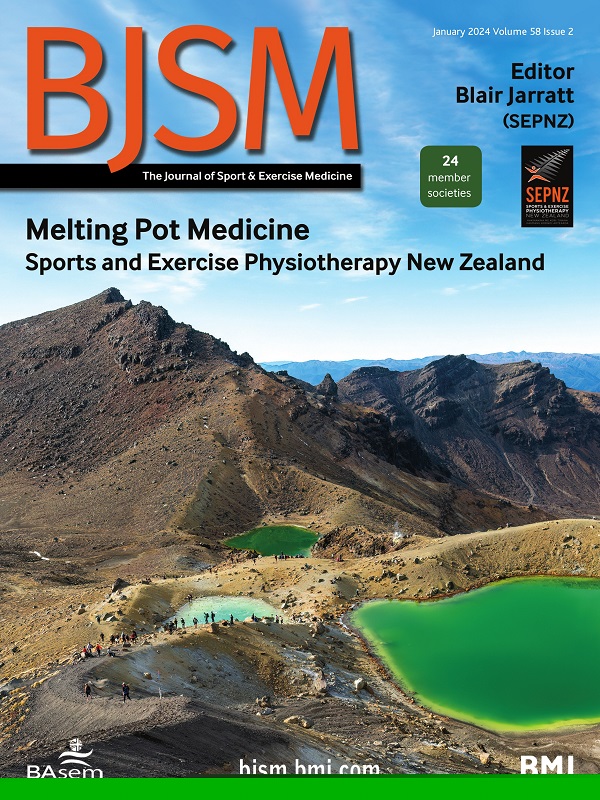健身应用能长期有效吗?对516818名加拿大健身应用用户进行了为期24个月的准实验
IF 16.2
1区 医学
Q1 SPORT SCIENCES
引用次数: 0
摘要
目的研究具有非常小(“微”)财务激励(FI)的多组件商业健身应用程序是否在2年内增加了人口水平的设备评估的身体活动(PA)。次要目的是探讨所选协变量对纵向效应的影响。方法于2016年12月至2019年6月在加拿大最大省份安大略省进行为期24个月的准实验。在1到2周的基准期后,用户完成每日步数目标可获得小额fi(每天0.04加元)。多元线性回归模型估计了从基线到关键时间点(如24个月)的每周平均每日步数的变化。为了解决次要目标,针对所选协变量的每个水平(例如,开始季节,基线PA)开发了单独的模型。结果样本包括516818名用户,其中女性占62.83,年龄(SD): 33.46(12.65)岁。一半的人在基线时活动量“低”(<5000每日步数;47.15%)。总体而言,在所有关键时间点,每日步数均大于基线(例如,24个月时每天242步;p<0.001)。较早开始季节和较长FI暴露时间的用户与基线的差异较大(例如,24个月时758步/天;p<0.001)。“低”活跃用户之间的差异也更为明显(例如,24个月时每天走1986步;p<0.001)。在“非常高”的活跃用户中观察到大量的每日步数减少(≥10,000每日步数;例如,24个月时- 3969步数/天;p<0.001)。结论PA适度增加约250步/天,持续2年以上。对于重要的亚组(即较早的开始季节,“低”活跃),增加接近或超过1000步/天-表明临床意义的水平。活跃度高的用户每天的步数也明显减少。如有合理要求,可提供资料。本文章由计算机程序翻译,如有差异,请以英文原文为准。
Can fitness apps work long term? A 24-month quasiexperiment of 516 818 Canadian fitness app users
Objective To examine whether a multicomponent commercial fitness app with very small (‘micro’) financial incentives (FI) increased population-level device-assessed physical activity (PA) over 2 years. The secondary objective was to explore the influence of select covariates on longitudinal effects. Methods This 24 month pre–post quasiexperiment was conducted in Ontario, Canada’s largest province (December 2016–June 2019). Following a 1-to-2 week baseline period, users earned micro-FIs ($0.04 CAD/day) for achieving daily step goals. Multiple linear regression models estimated changes in weekly mean daily step count from baseline to key timepoints (eg, 24 months). To address the secondary objective, separate models were developed for each level of the selected covariates (eg, start season, baseline PA). Results The sample included 516 818 users (% female: 62.83; age (SD): 33.46 (12.65) years). Half were ‘low’ active at baseline (<5000 daily steps; 47.15%). Overall, daily step counts were greater than baseline at all key timepoints (eg, 242 steps/day at 24 months; p<0.001). Users from earlier start seasons and longer FI exposure exhibited larger differences from baseline (eg, 758 steps/day at 24 months; p<0.001). Differences were also more pronounced among ‘low’ active users (eg, 1986 steps/day at 24 months; p<0.001). Substantial daily step count reductions were observed among ‘very high’ active users (≥10 000 daily steps; eg, −3969 steps/day at 24 months; p<0.001). Conclusion Modest PA increases of about 250 steps per day were sustained over 2 years. For important subgroups (ie, earlier start seasons, ‘low’ active) increases approached or surpassed 1000 steps/day—a level indicative of clinical significance. Substantial daily step count reductions among higher active users were also observed. Data are available upon reasonable request.
求助全文
通过发布文献求助,成功后即可免费获取论文全文。
去求助
来源期刊
CiteScore
27.10
自引率
4.90%
发文量
217
审稿时长
3-8 weeks
期刊介绍:
The British Journal of Sports Medicine (BJSM) is a dynamic platform that presents groundbreaking research, thought-provoking reviews, and meaningful discussions on sport and exercise medicine. Our focus encompasses various clinically-relevant aspects such as physiotherapy, physical therapy, and rehabilitation. With an aim to foster innovation, education, and knowledge translation, we strive to bridge the gap between research and practical implementation in the field. Our multi-media approach, including web, print, video, and audio resources, along with our active presence on social media, connects a global community of healthcare professionals dedicated to treating active individuals.

 求助内容:
求助内容: 应助结果提醒方式:
应助结果提醒方式:


